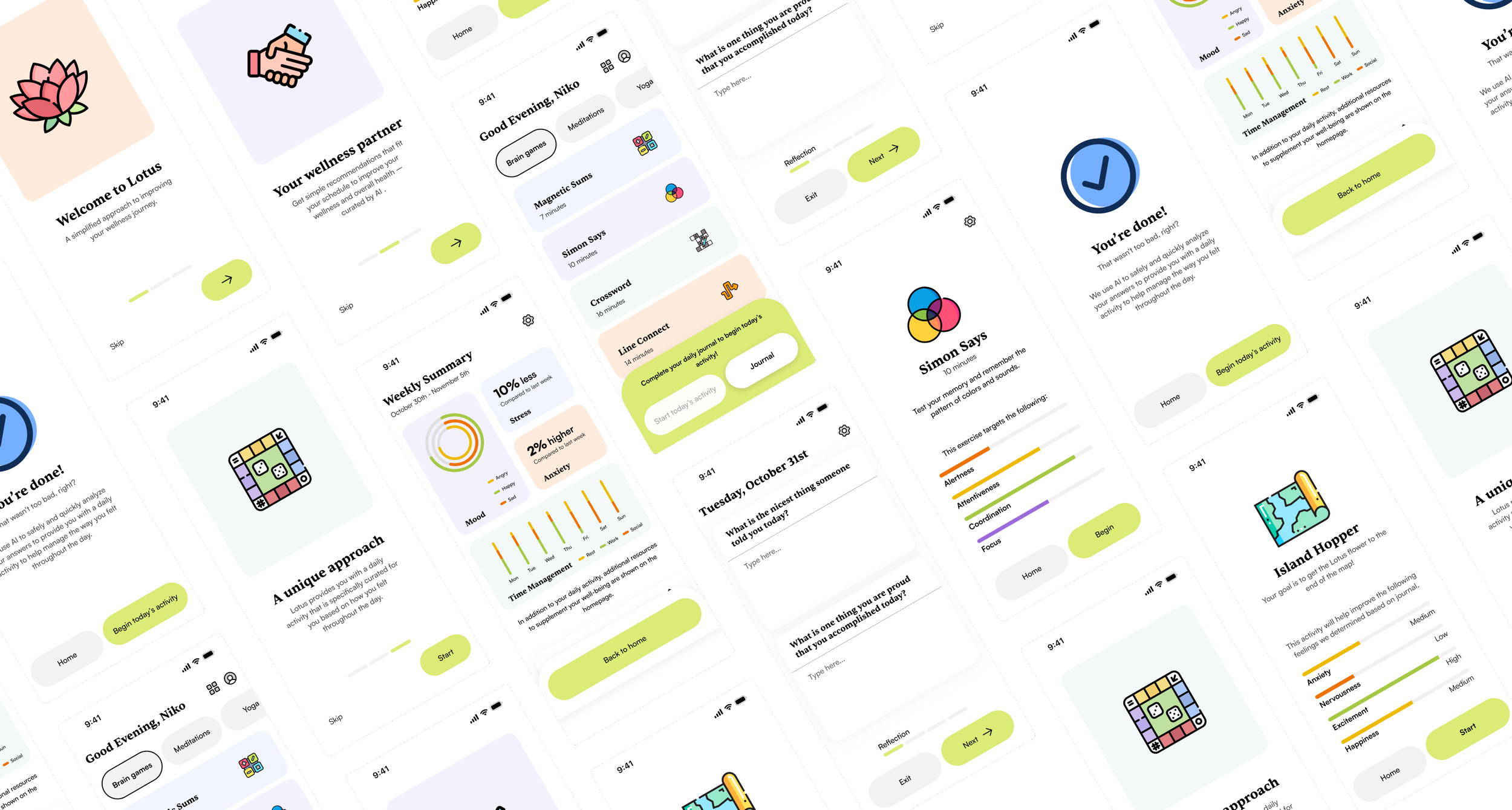Lotus
An unparalleled wellness application that prioritizes simplicity, empowering users to take command of their wellness journey with ease.
Project Overview
-
There is an increase in people looking to develop their health and build healthy habits that foster sustainable lifestyles that meet the needs of busy and demanding lives.
Create a new app that offers something new and considers the interests of its users and clients’ partnerships.
-
Differentiate from the competitors such as Headspace, MyFitnessPal, etc
Build a culture of health and wellness
Have a personalized experience that tailors to the needs of the users
Decrease user screen time and give the ability for users to track healthy habits
-
Project Scope
Propose a concept for a new wellness mobile application
Tools
Figma
Role
UX/UI Designer
Timeline
2023 · 4 weeks
Research
Project & Business Goals
Prior to jumping into designing, I conducted a thorough analysis of the project's scope, aligning my understanding with the needs and expectations of both users and the business. This involved delving into user preferences to inform feature selection and meticulously crafting user flows to guide seamless navigation within the new mobile application. Simultaneously, I needed to get a clear understanding of the company's objectives, ensuring that my design not only met but exceeded their expectations, both in terms of aesthetics and brand alignment, ultimately contributing to heightened user retention.
Business Goals
Increase user acquisition and brand loyalty
Build a culture of health and wellness
Differentiate from other wellness apps on the market, such as Headspace, Calm, Apple Health, MyFitnessPal, and others.
User Goals
Have a simple onboarding process
Understand the benefits of this app (Lotus) versus all the others
Have a personalized experience that is tailored to each user based on their preferences and wellness journey
Research Highlights
Going into this project, the client completed some of their own research and noted some of the following pain points amongst existing users in the wellness market. My goal was to address these pain points in the new application while also using my findings from a competitor analysis I completed of the most popular wellness apps to understand what works and what doesn't. This part of the research helped me create Lotus, a unique, standalone app that addresses user pain points.
Pain Points
Decrease screen time and don’t want something too overwhelming
Ability to track healthy habits
Help focus on the most important aspects throughout the day
Access supportive activities on a wide range of topics
Customize their experience to tailor to specific needs
Share content with friends and family
User Stories & User Mapping
With the market research completed, I created 25 unique user stories to get as many ideas for the application as possible. Each user story had a different user with a unique set of problems and needs they wanted to address. Once I completed my user stories, I worked on story mapping the user experience with my team to address all the possible processes and features that could be addressed in the new app. My team and I answered the following questions.
What are all of the things that a user can possibly do in or with the app?
What are the tiny tasks that support the top tasks (stated in the question above)?
For each activity, what are the top tasks that each user must complete in order to achieve their goal?
User Flows
With the preliminary research and story mapping completed, I created three distinct user flows that addressed the most common pain points. Addressing these pain points was based on the most requested user features from preliminary research. In all three user stories, I incorporated unique ways for users to customize their experience, one of the most important aspects of a wellness application. My decisions during this process were based on how I could directly address the user's goals with a clear and intuitive navigation design.
Personas
I created two personas using the research findings to represent potential future users of Lotus. The following two personas are based on my research findings. I made a persona for two likely user groups to address and outline their goals, needs, and frustrations directly. Creating personas helped me gain empathy for the user and mitigate assumptions by grounding design decisions in user research.
Visual Direction
I chose my specific design direction from my preliminary inspiration from my mood board. For example, my color palette is meant to evoke particular emotions, such as calmness, freshness, and serenity, distilling a positive user experience and a sense of wellness within the application.
Solution
-
Users are presented with a unique daily activity that directly addresses negative emotions felt throughout the day. AI uses questions that change daily to analyze and understands user’s emotions when curating the daily activity.
-
At the end of each week, users are presented with a summary, outlining the emotions that were most prominent. The summary also includes indicators displaying the users’ progress minimizing negative emotions and more.
-
In addition to the daily activity, supplemental workouts and games on the home screen accompany a user's wellness journey. These activities are curated by AI, built on simplicity, addressing all of the user emotions felt throughout the week.
My Impact
This design challenge resulted in an “A” from my professor, who enjoyed the unique concept for its simplicity and carefully crafted UI elements and design, following common UX design principles. My professor was also pleased with my idea for the AI-generated daily activity, which incorporates a new and fresh concept in the crowded world of health-focused apps.












